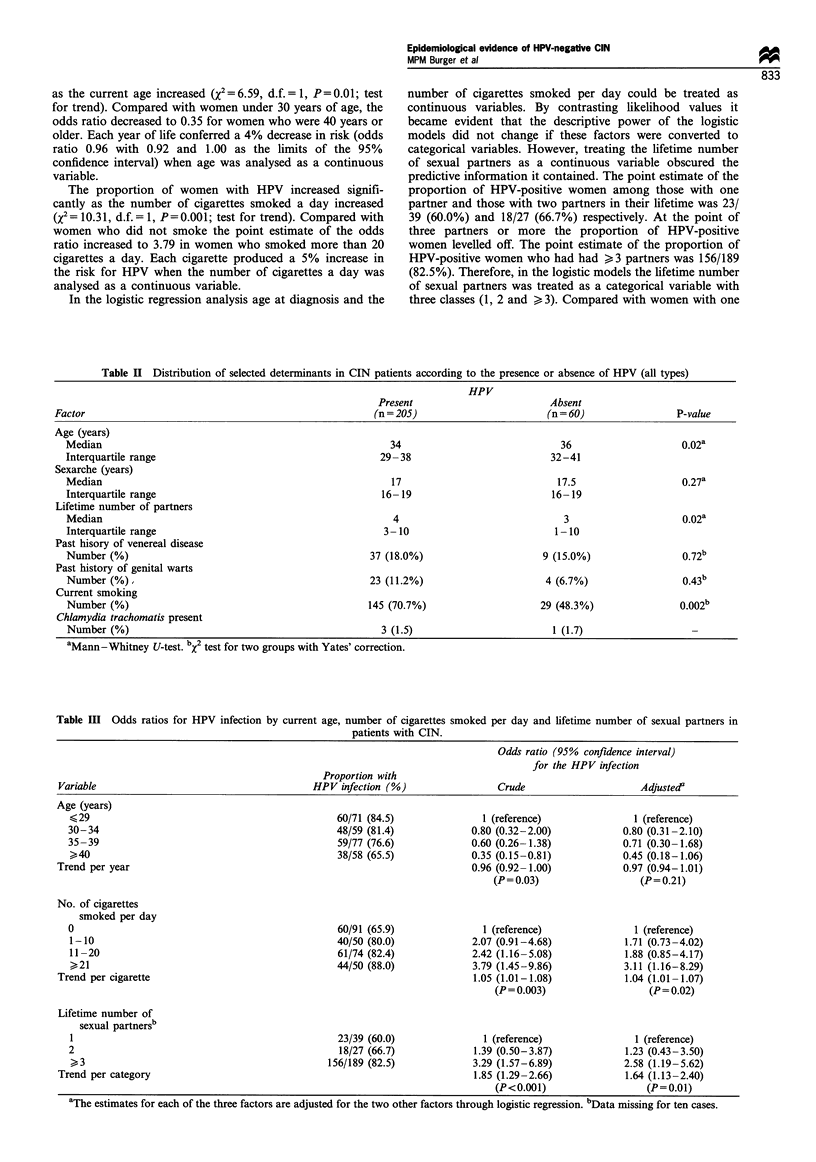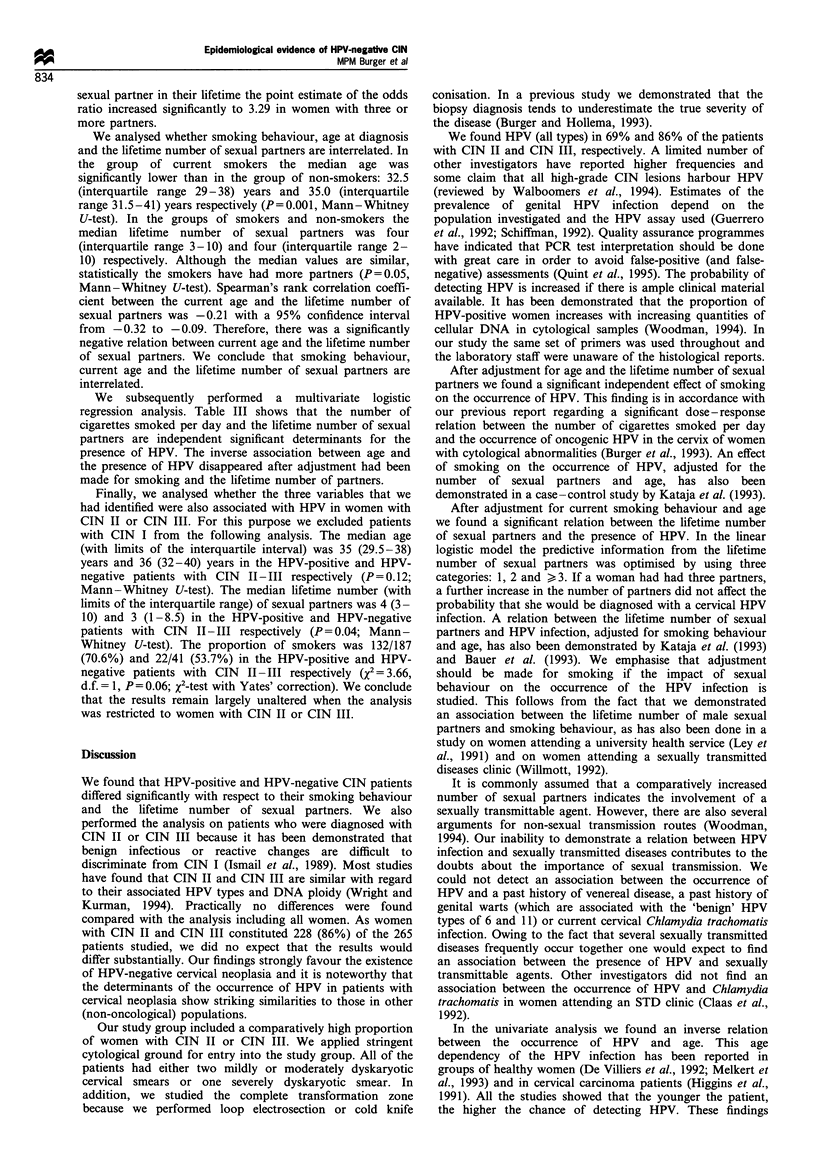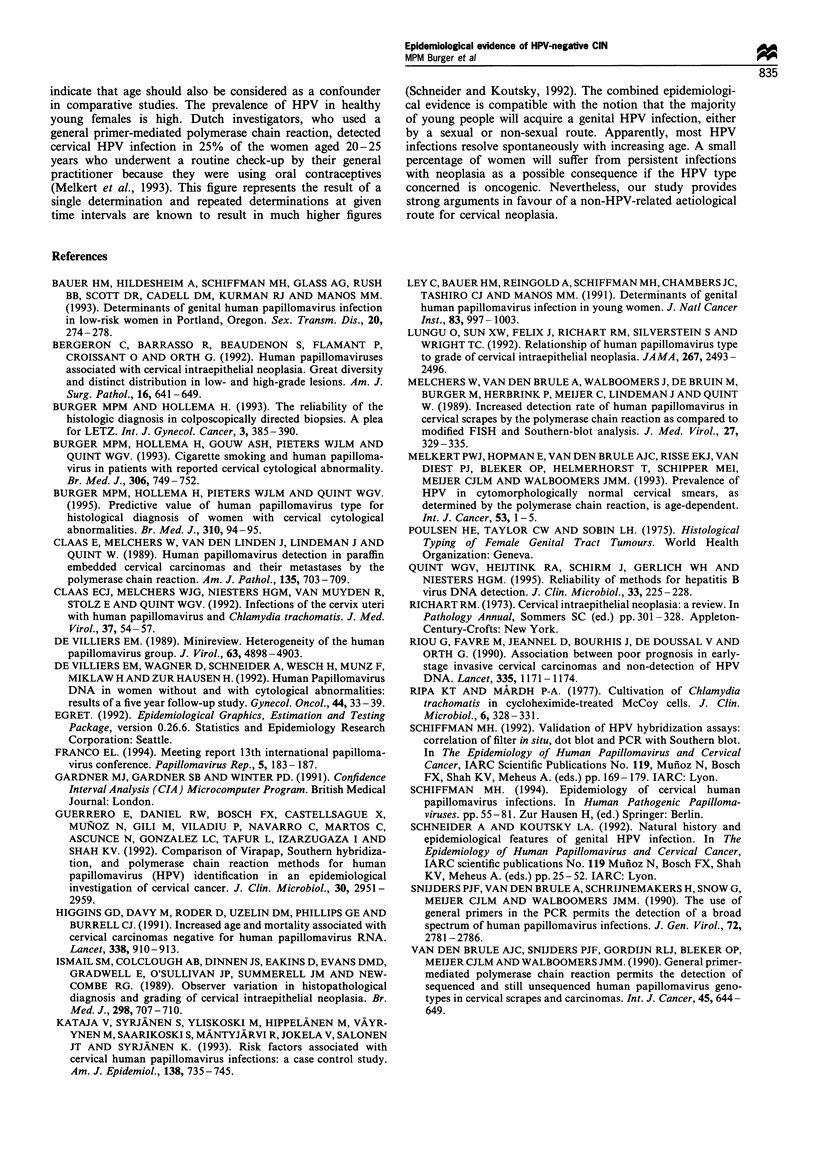Abstract
The aim of this paper was to provide epidemiological evidence to support the notion that cervical intraepithelial neoplasia (CIN) without human papillomavirus (HPV) is a true entity. If a diagnosis of HPV-negative cervical neoplasia is erroneous, one would not expect there to be any differences in risk factors between HPV-positive and HPV-negative patients. Patients at a gynaecological outpatient clinic of a university hospital [a total of 265 consecutive women with dyskaryotic cervical smears who were subsequently diagnosed with CIN I (n=37), CIN II (n=48) or CIN III (n=180)] completed a structured questionnaire regarding smoking habits and sexual history. Analysis of an endocervical swab for Chlamydia trachomatis, analysis of a cervical scrape for HPV, and morphological examination of cervical biopsy specimens were also performed. HPV was found in 205 (77.4%) out of the 265 women. Univariate analysis showed that current age (P=0.02), current smoking behaviour (P=0.002) and the number of sexual partners (P=0.02) were significantly associated with the presence of HPV. Age at first sexual intercourse, a past history of venereal disease or genital warts, and current infection with Chlamydia trachomatis were not associated with the presence of HPV. Using multivariate logistic regression analysis, the number of sexual partners and current smoking behaviour showed an independent significant association with HPV. HPV-negative and HPV-positive CIN patients differ with respect to the risk factors for HPV. These findings suggest that HPV-negative CIN is a separate true entity.
Full text
PDF





Selected References
These references are in PubMed. This may not be the complete list of references from this article.
- Bauer H. M., Hildesheim A., Schiffman M. H., Glass A. G., Rush B. B., Scott D. R., Cadell D. M., Kurman R. J., Manos M. M. Determinants of genital human papillomavirus infection in low-risk women in Portland, Oregon. Sex Transm Dis. 1993 Sep-Oct;20(5):274–278. doi: 10.1097/00007435-199309000-00007. [DOI] [PubMed] [Google Scholar]
- Bergeron C., Barrasso R., Beaudenon S., Flamant P., Croissant O., Orth G. Human papillomaviruses associated with cervical intraepithelial neoplasia. Great diversity and distinct distribution in low- and high-grade lesions. Am J Surg Pathol. 1992 Jul;16(7):641–649. doi: 10.1097/00000478-199207000-00002. [DOI] [PubMed] [Google Scholar]
- Burger M. P., Hollema H., Gouw A. S., Pieters W. J., Quint W. G. Cigarette smoking and human papillomavirus in patients with reported cervical cytological abnormality. BMJ. 1993 Mar 20;306(6880):749–752. doi: 10.1136/bmj.306.6880.749. [DOI] [PMC free article] [PubMed] [Google Scholar]
- Burger M. P., Hollema H., Pieters W. J., Quint W. G. Predictive value of human papillomavirus type for histological diagnosis of women with cervical cytological abnormalities. BMJ. 1995 Jan 14;310(6972):94–95. doi: 10.1136/bmj.310.6972.94. [DOI] [PMC free article] [PubMed] [Google Scholar]
- Burger M.P.M., Hollema H. The reliability of the histologic diagnosis in colposcopically directed biopsies. A plea for LETZ. Int J Gynecol Cancer. 1993 Nov;3(6):385–390. doi: 10.1046/j.1525-1438.1993.03060385.x. [DOI] [PubMed] [Google Scholar]
- Claas E. C., Melchers W. J., Niesters H. G., van Muyden R., Stolz E., Quint W. G. Infections of the cervix uteri with human papillomavirus and Chlamydia trachomatis. J Med Virol. 1992 May;37(1):54–57. doi: 10.1002/jmv.1890370109. [DOI] [PubMed] [Google Scholar]
- Claas E. C., Melchers W. J., van der Linden H. C., Lindeman J., Quint W. G. Human papillomavirus detection in paraffin-embedded cervical carcinomas and metastases of the carcinomas by the polymerase chain reaction. Am J Pathol. 1989 Oct;135(4):703–709. [PMC free article] [PubMed] [Google Scholar]
- Guerrero E., Daniel R. W., Bosch F. X., Castellsagué X., Muñoz N., Gili M., Viladiu P., Navarro C., Zubiri M. L., Ascunce N. Comparison of ViraPap, Southern hybridization, and polymerase chain reaction methods for human papillomavirus identification in an epidemiological investigation of cervical cancer. J Clin Microbiol. 1992 Nov;30(11):2951–2959. doi: 10.1128/jcm.30.11.2951-2959.1992. [DOI] [PMC free article] [PubMed] [Google Scholar]
- Higgins G. D., Davy M., Roder D., Uzelin D. M., Phillips G. E., Burrell C. J. Increased age and mortality associated with cervical carcinomas negative for human papillomavirus RNA. Lancet. 1991 Oct 12;338(8772):910–913. doi: 10.1016/0140-6736(91)91773-n. [DOI] [PubMed] [Google Scholar]
- Ismail S. M., Colclough A. B., Dinnen J. S., Eakins D., Evans D. M., Gradwell E., O'Sullivan J. P., Summerell J. M., Newcombe R. G. Observer variation in histopathological diagnosis and grading of cervical intraepithelial neoplasia. BMJ. 1989 Mar 18;298(6675):707–710. doi: 10.1136/bmj.298.6675.707. [DOI] [PMC free article] [PubMed] [Google Scholar]
- Kataja V., Syrjänen S., Yliskoski M., Hippelïnen M., Väyrynen M., Saarikoski S., Mäntyjärvi R., Jokela V., Salonen J. T., Syrjänen K. Risk factors associated with cervical human papillomavirus infections: a case-control study. Am J Epidemiol. 1993 Nov 1;138(9):735–745. doi: 10.1093/oxfordjournals.aje.a116911. [DOI] [PubMed] [Google Scholar]
- Ley C., Bauer H. M., Reingold A., Schiffman M. H., Chambers J. C., Tashiro C. J., Manos M. M. Determinants of genital human papillomavirus infection in young women. J Natl Cancer Inst. 1991 Jul 17;83(14):997–1003. doi: 10.1093/jnci/83.14.997. [DOI] [PubMed] [Google Scholar]
- Lungu O., Sun X. W., Felix J., Richart R. M., Silverstein S., Wright T. C., Jr Relationship of human papillomavirus type to grade of cervical intraepithelial neoplasia. JAMA. 1992 May 13;267(18):2493–2496. [PubMed] [Google Scholar]
- Melchers W., van den Brule A., Walboomers J., de Bruin M., Burger M., Herbrink P., Meijer C., Lindeman J., Quint W. Increased detection rate of human papillomavirus in cervical scrapes by the polymerase chain reaction as compared to modified FISH and southern-blot analysis. J Med Virol. 1989 Apr;27(4):329–335. doi: 10.1002/jmv.1890270413. [DOI] [PubMed] [Google Scholar]
- Quint W. G., Heijtink R. A., Schirm J., Gerlich W. H., Niesters H. G. Reliability of methods for hepatitis B virus DNA detection. J Clin Microbiol. 1995 Jan;33(1):225–228. doi: 10.1128/jcm.33.1.225-228.1995. [DOI] [PMC free article] [PubMed] [Google Scholar]
- Richart R. M. Cervical intraepithelial neoplasia. Pathol Annu. 1973;8:301–328. [PubMed] [Google Scholar]
- Riou G., Favre M., Jeannel D., Bourhis J., Le Doussal V., Orth G. Association between poor prognosis in early-stage invasive cervical carcinomas and non-detection of HPV DNA. Lancet. 1990 May 19;335(8699):1171–1174. doi: 10.1016/0140-6736(90)92693-c. [DOI] [PubMed] [Google Scholar]
- Ripa K. T., Mårdh P. A. Cultivation of Chlamydia trachomatis in cycloheximide-treated mccoy cells. J Clin Microbiol. 1977 Oct;6(4):328–331. doi: 10.1128/jcm.6.4.328-331.1977. [DOI] [PMC free article] [PubMed] [Google Scholar]
- Schiffman M. H. Epidemiology of cervical human papillomavirus infections. Curr Top Microbiol Immunol. 1994;186:55–81. doi: 10.1007/978-3-642-78487-3_4. [DOI] [PubMed] [Google Scholar]
- Willmott F. E. Current smoking habits and genital infections in women. Int J STD AIDS. 1992 Sep-Oct;3(5):329–331. doi: 10.1177/095646249200300505. [DOI] [PubMed] [Google Scholar]
- de Villiers E. M. Heterogeneity of the human papillomavirus group. J Virol. 1989 Nov;63(11):4898–4903. doi: 10.1128/jvi.63.11.4898-4903.1989. [DOI] [PMC free article] [PubMed] [Google Scholar]
- de Villiers E. M., Wagner D., Schneider A., Wesch H., Munz F., Miklaw H., zur Hausen H. Human papillomavirus DNA in women without and with cytological abnormalities: results of a 5-year follow-up study. Gynecol Oncol. 1992 Jan;44(1):33–39. doi: 10.1016/0090-8258(92)90008-7. [DOI] [PubMed] [Google Scholar]
- van den Brule A. J., Snijders P. J., Gordijn R. L., Bleker O. P., Meijer C. J., Walboomers J. M. General primer-mediated polymerase chain reaction permits the detection of sequenced and still unsequenced human papillomavirus genotypes in cervical scrapes and carcinomas. Int J Cancer. 1990 Apr 15;45(4):644–649. doi: 10.1002/ijc.2910450412. [DOI] [PubMed] [Google Scholar]


